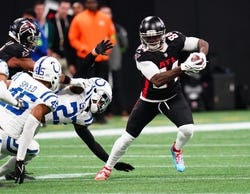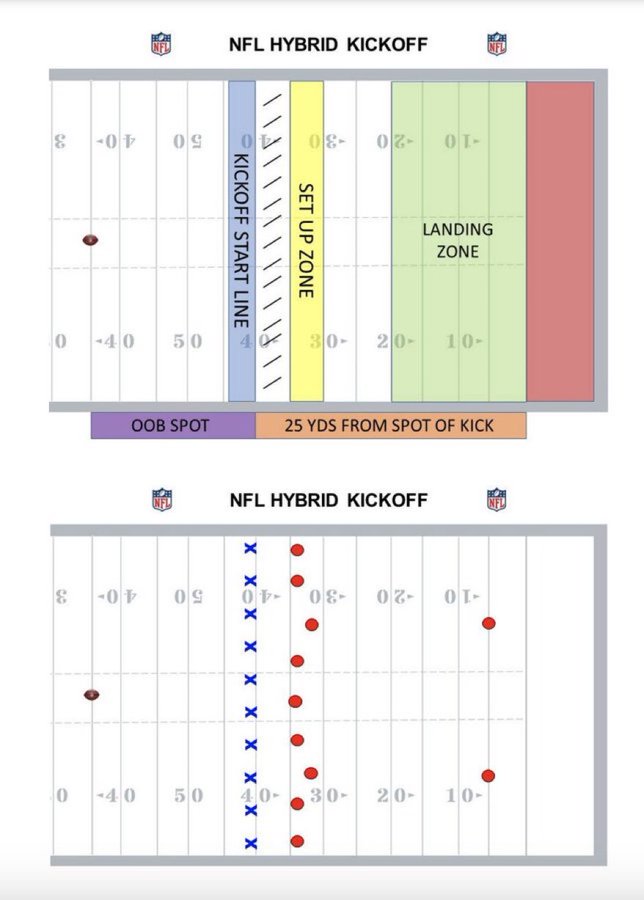Creative NFL rule: Return of the return

The biggest news out of the NFL Owners meeting in Orlando, Tuesday, was the return of the return. After suffering through a Super Bowl XVII in February with touchbacks on all 13 kickoffs, fans should see the drama of returns and new strategies become a factor in the game's outcome.
"This is going to be brand new to everybody," said New Orleans Saints special teams coordinator Darren Rizzi, who worked closely with the Competition Committee on the redesign. "But the big thing is we feel we've made this play extremely relevant and, more importantly, a lot safer."
Other rules addressed included making the "hip-drop tackle"— a cousin of the horse-collar — officially illegal.
The kickoff rule change comes on the same year that star returner Devin Hester will be inducted into the Pro Football Hall of Fame. Hester opened Super Bowl XLI with a 92-yard kickoff return touchdown. For his career, Hester took 14 punts and five kickoffs to the end zone in 156 regular-season games.
And, not coincidentally, a couple of hours after the rule was adopted, the Pittsburgh Steelers signed Cordarrelle Patterson to a $6 million, two-year contract. Patterson holds the NFL record with nine touchdowns on kickoff returns. Next we are wondering if this will impact the draft rating of former Texas wide receiver Xavier Worthy, who set a Combine record of 4.21 seconds in the 40-yard dash.
XFL influence
The XFL developed this kickoff approach in 2020 and now it will be installed as a one-year experiment in the NFL. It is a creative approach to bringing back what was once one of the most exciting plays in football — and one of the most dangerous. The new approach avoids players running full speed for 40 yards and then slamming into blockers or returners.
The foundation of this approach is to line up the majority of players downfield before the kick rather than have them run there while the ball is in the air. That shift should reduce the number of high-speed collisions that cause injuries. The kicker will continue to kick off from his 35-yard line, but the remaining 10 members of the kicking team will line up at the receiving team's 40-yard line. At least nine members of the return team will be between their 35- and 30-yard lines in what's called the "setup zone."
Schematically, this is what it will look like:
The ball ideally will drop between the 20-yard line and the goal line, called the "landing zone," where the receiving team will probably have two returners. If the ball lands in the end zone or goes out of the end zone, the resulting touchback will be spotted at the 30-yard line. If it's kicked out of bounds, the ball will be placed at the 40.
No one but the kicker and returner(s) can move until the ball is caught or hits the ground. That will create an admittedly awkward few seconds when 19 or 20 players are standing still while the ball is in the air.
"It looks a little bit strange," Rizzi said. "It's not the football that we all grew up watching. But we expect to see a lot of creativity, and maybe even different types of players.
"The kicking team will be able to see the ball touch the ground or the returner, and likely have a bit of an advantage," Rizzi offered. "The question was one of many that nearly 60 special-teams coaches discussed in February at the NFL Combine.
"I think some coaches will teach their return unit in the setup zone to go and work off of the kickoff team and kind of react," Rizzi said. "And I think some guys maybe have the vision in the back and their eyes back to the returner, and they'll go on the touch. So again, in talking with all the coaches, I think it's going to be one of those things that they work maybe a couple different ways in camp and kind of see what the best is. It's going to be a work in progress."
Impact on injuries
The NFL spent more than a decade trying to address the high injury rates on kickoffs by adopting rules designed to reduce returns via touchbacks and fair catches. By 2023, only 21 percent of kickoffs were returned. The Competition Committee projects that 50–60 percent of kickoffs will be returned in 2024. That would add roughly 1,000 plays to the NFL's season.
The original projection was for 80–90 percent returns. But the Committee made one tweak this week to the original proposal, moving the touchback spot from the 35- to the 30-yard line, a compromise that helped the proposal get enough support to pass. It will reduce the incentive for the kicking team to avoid a touchback but would still represent a big jump in the return rate.
"A team might not feel good about their ability to cover kicks that week," said Dallas Cowboys special teams coordinator John Fassel. "Or the team feels like they're kicking to a great returner or a kick return team that has an incredible drive start, it might just want to have a touchback."
What happens with onside kicks?
Teams must declare their intent to use an onside formation, which will look like the traditional formation used up until this season. That rules out the possibility of a surprise onside kick, a big allure that doesn't get used nearly as often as it might seem. In 2023, for example, there were two in 272 regular-season games.
As for squib kicks, under the new rule, any kick that lands short of the 20-yard line will be ruled down immediately and marked at the 40-yard line. That would eliminate the squib in most situations.
"Those strategical parts of the [old] kickoff at the half and at the end of the game, where you can maybe eliminate some time off the clock with a squib kick and things like that, that element is going to be gone as well," Rizzi said.
Skyrocketing value
We should expect personnel implications beyond the signing of Patterson.
The educated guess among coaches this week is that most teams will use two returners, because there are field-position ramifications if a ball touches the ground in the landing zone. A member of the kicking team could beat a single returner to it and, because it's a live ball, recover it for a change of possession. If the ball lands in the field of play, then rolls into the end zone and there is a touchback, it will be marked at the 20-yard line rather than the 30.
For that reason, and because of the expected rise in returns, the value of kickoff returners is going to "skyrocket," Fassel said.
Teams might also recalibrate the makeup of their depth to account for the fact there will be more in-line blocking, and less running, on kickoffs. One coach suggested that offensive and defensive linemen could have more frequent use in those situations.
Detroit Lions coach Dan Campbell said he and special teams coordinator Dave Fipp are excited about the possibility of strategic innovation.
"You want to feel like you're going to do something that is a little unique or something they're not prepared for," Campbell said. "And, really, that's what it is, right? You're wanting to try to find something they're not ready for, not prepared for, whatever that is. Maybe it's been done, maybe it hasn't."
More unpredictable field position
Not everybody voted for this new kickoff.
San Francisco 49ers owner Jed York was one of three owners to vote against the proposal. He said Tuesday he is fully in favor of shifting it to "more of a real play as opposed to a ceremonial play." But considering what he called a "drastic change," York hoped there would be a way to tweak the rule during the season if immediate unintended consequences arise.
"I'm a hundred percent for trying to make that play active in our game again," York said. "And I think they put in a ton of time, a ton of effort to try to make something work. I'm just sure that there's going to be tweaks to it, and I'd rather tweak it if we have to in the middle of the season as opposed to, 'Here's the asterisk season, and then we're going to tweak it at the end of the year.'"
Field position will be one of those potential consequences.
According to Fassel, the average starting position of drives will be much more unpredictable given the potential variance of return strategy. Based on numbers he provided Tuesday, 80 percent of drives last season started around the 25-yard line. The projections for the new rule indicate that 40 percent of drives will start at the 30-yard line or higher. Another 30 percent will start inside the 20-yard line. And the remaining 30 percent would start between the 20- and 30-yard line.
"I think there was a little bit of a scare factor for some teams where 'I don't know if the ball starts at the 12 to 25 or the 39," he said. "But the unpredictability of it, I think, is also exciting. So you're going to get a lot more variance and drive starts using this model than the previous one, which I think is good."
The key metric the NFL has been following is the concussion rate, which for kickoffs has been anywhere from three to five times that of typical offensive plays over the past decade, because of the nature of the collisions.
"The goal," said NFL Executive Vice President of Communications, Public Affairs and Policy Jeff Miller, "is to get the injury rate and concussion rate to be very similar to a run or pass play from scrimmage. Will it be a little bit higher? Will it be the same? Will be a little bit lower?
"We're going to have to see how the teams strategize, but we've created the mechanisms by bringing the players closer and minimizing the space that we think it should be in that zone. Then if we need to tinker with and tailor that after we get some data after the year, then we'll be OK. Does it it help? For sure."
